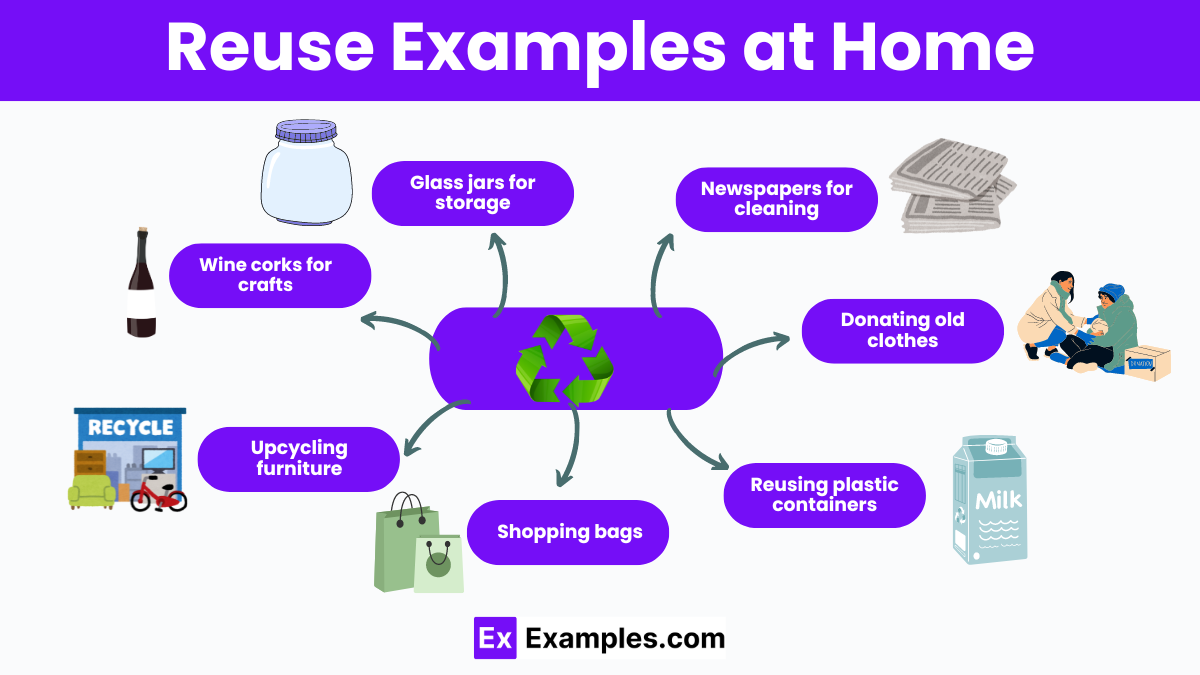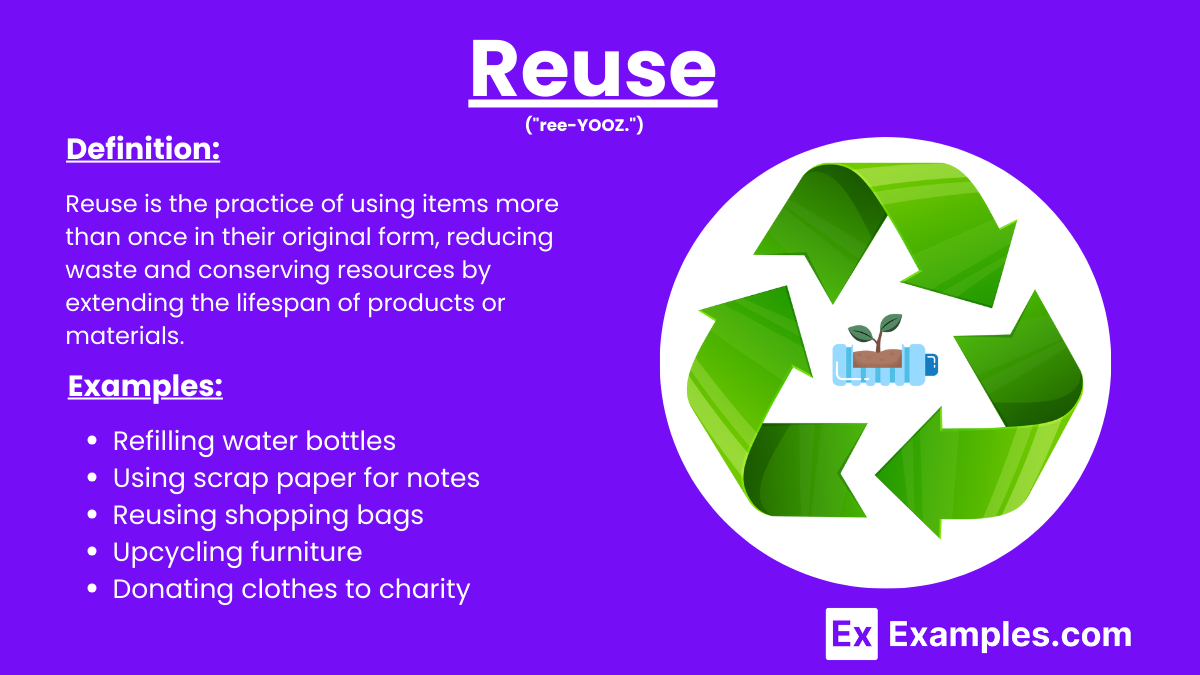25+ Reuse Examples
Reuse is the practice of using an item multiple times before discarding it. This concept plays a crucial role in waste management, sustainability, and environmental conservation. By choosing to reuse, individuals and businesses can significantly reduce waste, conserve natural resources, and lower carbon footprints. Simple actions like repurposing containers, donating old clothes, and upcycling furniture exemplify reuse. Additionally, green marketing strategies often highlight reuse initiatives to attract environmentally conscious consumers. Embracing reuse contributes to a circular economy, promoting long-term ecological balance and resource efficiency.
What is Reuse?
Reuse is the process of using an item multiple times before disposing of it. This practice reduces waste, conserves resources, and supports sustainability by extending the life cycle of products, minimizing environmental impact, and promoting efficient resource utilization.
Reuse Examples
- Repurposing glass jars as storage containers
- Using old newspapers for cleaning windows
- Donating clothes to charity
- Refilling water bottles
- Reusing gift bags and wrapping paper
- Turning old tires into garden planters
- Using scrap paper for notes
- Repurposing wooden pallets into furniture
- Using empty cans for organizing tools
- Reusing shopping bags
- Upcycling furniture
- Using old toothbrushes for cleaning
- Transforming mason jars into candle holders
- Using old blankets as pet bedding
- Creating art from scrap materials
- Reusing envelopes for internal mail
- Turning old t-shirts into cleaning rags
- Repurposing coffee grounds as fertilizer
- Using egg cartons for seed starters
Reuse Examples at Home

- Glass jars for storage
- Newspapers for cleaning
- Donating old clothes
- Reusing plastic containers
- Shopping bags
- Upcycling furniture
- Egg cartons for seed starters
- Coffee grounds as fertilizer
- Cardboard boxes for storage
- Wine corks for crafts
Reuse Process
- Identify Reusable Items – Determine which items can be reused, such as containers, clothing, or electronics.
- Clean and Repair – Thoroughly clean and fix any damages to ensure the items are safe and functional.
- Repurpose Creatively – Find new uses for the items, like turning jars into storage or old shirts into cleaning rags.
- Share or Donate – Give reusable items to friends, family, or charitable organizations that can make use of them.
- Implement Regularly – Incorporate reuse into your daily routine to reduce waste and promote sustainability.
Reuse in waste management
- Identify Reusable Items: Sort waste to find reusable materials, reducing overall waste and conserving valuable resources.
- Collect Items: Gather identified reusable items to prevent their discard and facilitate further reuse processes, incorporating a systematic schema for efficient organization..
- Clean and Repair: Clean and fix items to ensure usability, extending their life cycle and functionality.
- Repurpose: Find new uses for items, turning them into functional products or tools for various purposes.
- Donate: Give reusable items to charities, providing resources to those in need and reducing landfill waste.
- Upcycle: Transform items into new products, adding value and promoting sustainable practices.
- Sell: Host garage sales or use online platforms to sell reusable items, reducing waste.
- Educate: Promote reuse benefits and methods in the community to encourage waste reduction efforts.
Reuse Before You Recycle
- Identify Reusable Items: Sort waste to find reusable materials, reducing overall waste and conserving valuable resources.
- Collect Items: Gather identified reusable items to prevent them from being discarded and to facilitate further reuse processes.
- Clean and Repair: Clean and fix items to ensure usability, extending their life cycle and functionality.
- Repurpose: Find new uses for items, turning them into functional products or tools for various purposes.
- Donate: Give reusable items to charities, providing resources to those in need and reducing landfill waste.
- Upcycle: Transform items into new products, adding value and promoting sustainable practices.
- Sell: Host garage sales or use online platforms to sell reusable items, reducing waste.
- Educate: Promote reuse benefits and methods in the community to encourage waste reduction efforts by discussing them in an essay on recycling.
Essentials of Recycling
- Sorting: Properly separate recyclables from non-recyclables to ensure effective processing.
- Cleaning: Rinse and clean items to remove food residue and contaminants.
- Educating: Stay informed about local recycling guidelines and accepted materials.
- Reducing Contamination: Avoid placing non-recyclable items in recycling bins to prevent contamination.
- Proper Disposal: Ensure that hazardous materials like batteries and electronics are recycled at designated centers.
- Community Participation: Encourage community involvement and participation in recycling programs.
- Supporting Recycling Programs: Purchase products made from recycled materials to support the recycling market.
- Recycling Centers: Utilize local recycling centers and drop-off locations for items not collected curbside.
- Awareness: Spread awareness about the benefits of recycling to make sustainability a key life goal for everyone.
- Government Policies: Advocate for and comply with government recycling regulations and policies.
Repurposing Everyday Items
- Survey Your Home: Conduct a thorough inventory of items you rarely use, considering their potential for repurposing.
- Research Ideas: Look up innovative repurposing ideas online to spark creativity and find practical applications.
- Plan Your Project: Sketch or plan how you will transform the item, listing needed tools and materials.
- Gather Materials: Collect all necessary materials, including any additional items required for the transformation.
- Test Functionality: Before finalizing, test the repurposed item to ensure it effectively serves its new purpose, demonstrating the cause and effect of successful repurposing..
- Document the Process: Take photos or write a step-by-step guide of your repurposing project to share with others.
- Evaluate and Adjust: Assess the practicality of the repurposed item and make any necessary adjustments for improved functionality.
Reuse of Waste
- Old Clothes: Turn old t-shirts into cleaning rags or DIY tote bags.
- Glass Jars: Use glass jars for storing food, organizing small items, or as planters.
- Plastic Containers: Repurpose plastic containers for organizing tools, crafting supplies, or as lunchboxes.
- Newspapers: Use old newspapers for cleaning windows, wrapping gifts, or creating compost.
- Wine Corks: Make bulletin boards, coasters, or plant markers from used wine corks.
- Cardboard Boxes: Utilize cardboard boxes for storage, kids’ crafts, or as garden beds.
- Egg Cartons: Use egg cartons for seed starters or organizing small items like screws and buttons.
- Tin Cans: Transform tin cans into pencil holders, plant pots, or lanterns.
- Old Furniture: Upcycle old furniture with a fresh coat of paint or new upholstery.
- Electronics: Donate or sell working electronics, or repurpose parts for DIY projects.
Benefits of Reducing and Reusing
- Reduces Waste: Reuse minimizes the amount of waste sent to landfills, reflecting the values of sustainability and significantly reducing environmental impact..
- Conserves Resources: Reusing items decreases the demand for raw materials, conserving natural resources.
- Saves Energy: Less energy is needed to repurpose or refurbish items compared to manufacturing new products.
- Saves Money: Reusing products can save money by reducing the need to buy new items.
- Reduces Pollution: By reusing items, pollution from manufacturing and disposal processes is reduced.
- Promotes Creativity: Reuse encourages innovative thinking and creativity in finding new uses for old items.
- Supports Community: Donating reusable items helps those in need and strengthens community bonds.
- Encourages Sustainable Practices: Reuse fosters a culture of sustainability and responsibility towards the environment.
- Extends Product Lifespan: Reuse extends the life cycle of products, maximizing their utility.
- Reduces Carbon Footprint: By decreasing the demand for new products, reuse helps lower greenhouse gas emissions.
Reduce, Reuse, Recycle
| Aspects | Reduce | Reuse | Recycle |
|---|---|---|---|
| Consumption | Buy only what you need | Use glass jars for storage | Sort and dispose of recyclables properly |
| Packaging | Choose products with minimal packaging | Turn old clothes into cleaning rags | Follow local recycling guidelines |
| Single-Use | Avoid single-use items | Repurpose plastic containers | Recycle paper, plastic, glass, and metal |
| Durability | Opt for durable, long-lasting products | Transform tin cans into plant pots | Participate in community recycling programs |
| Energy & Water | Conserve water and energy | Upcycle old furniture | Recycle electronic waste at designated centers |
| Waste | Plan meals to avoid food waste | Repurpose cardboard boxes for storage | Compost organic waste |
Why is reuse important?
Reuse conserves resources, reduces waste, and promotes sustainability.
How can I start reusing items at home?
Start by identifying items you no longer need and find new uses for them.
Can all items be reused?
Not all items can be reused; focus on those that are durable and in good condition.
What are common items to reuse?
Common items include glass jars, plastic containers, clothing, and cardboard boxes.
How does reuse differ from recycling?
Reuse involves using an item again as-is, while recycling involves processing items to create new materials.
Can electronics be reused?
Yes, donate working electronics or repurpose parts for DIY projects.
What is upcycling?
Upcycling is creatively transforming old items into new, useful products.
How can businesses implement reuse practices?
Businesses can implement reuse by repurposing materials, donating surplus, and using durable supplies.
Are there any economic benefits to reuse?
Yes, reuse can save money by reducing the need to purchase new items.
Can reuse help reduce pollution?
Yes, reuse reduces pollution by minimizing the production and disposal processes.



